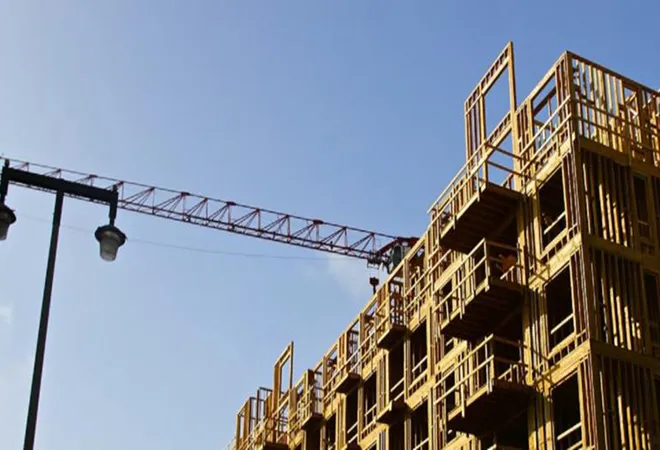-
CENTRES
Progammes & Centres
Location

Access to housing, that’s both affordable and dignified, is one of the critical challenges globally and more so in India. Over the past few decades, India had not done much on the developmental policies around social housing. Due to lack of focused policy planning & messy execution, the idea of rental housing slowed down. The concept of rental housing has been seen as ‘affirmative action’, rather than a need to build an inclusive society.
The right to housing and adequate shelter as guaranteed in the Directive Principles of State Policy enshrined in our Constitution, places an obligation on the Governments to ensure “housing for all”. The rental housing can be further divided into another inclusive idea called Social Rental Housing. In this category, the target audience to use this housing pool are the EWS & LIG citizens and the rental charged is kept way below the market rates. The housing pool could be owned by any entity or individual - both from public holding to private holding.
Until mid of this decade, price of real estate had been increasing over the previous 15-20 years. This had been made possible with increase in demand, coupled with availability with retail financing for home purchase. In some cities, it was also fuelled by property purchase by NRI remittances. However with increased urbanisation across India, the gap between demand and supply also widened. This dire situation of housing shortage is felt with pain, especially for the Economically Weaker Section (EWS) and Lower Income Groups (LIG).
With increased cost of land to build affordable housing, those projects (if at all) are left to the periphery of the cities, with resultant shortage of services like potable water, drainage system & sanitation facilities, electricity, roads and solid waste disposal. The urban housing shortage, estimated to be around 19 million and is continuing to increase.
Urbanisation in India has been propelled by economic compulsions where people moved out of villages & towns to larger cities for income generating opportunities.
With increased urbanisation over past many years, the metro cities in India have showcased an ugly side of social reality - explosive growth of ‘slums’. These cities uses the labour and skills offered by those slum dwellers and ignores the conversation around the plight of those who have migrated (prefer to call them ‘differently-domiciled labour force’) to those metros in search of livelihood.
"With increased urbanisation over past many years, the metro cities in India have showcased an ugly side of social reality - explosive growth of ‘slums’."
It has impacted negatively in the standard of living in urban pockets and also forced people to live in unsafe conditions. This undignified living condition has been necessitated by those who can’t afford the high rentals of a ‘pucca (permanent) construction’ in the cities.
With the current Covid-19 crisis, we have seen a large proportion of this labour force move out of the metros to their hometowns / villages. If the cities need to attract them back for labour & service tasks, the cities have to offer dignity to them.
Provision of affordable housing is now a priority area for the Government of India; however, providing housing for all on ownership basis is a challenge, despite the best efforts of the policies like PMAY. The fact that a large percentage of households live in congested condition, because the current cost of adequate housing is unaffordable.
In the past few decades, various state governments had tried without much energies, the concept of providing rental housing. The key attribute to its failure is the lack of adequate funding to maintain these physical structures and non-existent bureaucratic interest in that segment. The other deterrent to rental housing was the rent control laws, which created widened gap by dissuading the private investments in the rental housing space. The investors in rental housing would see low-rental yield, poor maintenance of the physical structures as the tenants cannot afford to pay for the upkeep. Therefore the formal rental market needs policy attention as it could aid in promoting affordable housing for the socially & economically weaker sections.
In 2015, the National Urban Rental Housing Policy (NURHP) was rolled out with a vision, ‘to create a vibrant, sustainable and inclusive rental housing market in India’. The broad objectives of the NURHP, 2015 included creating adequate rental housing stock by promoting Social Rental Housing (SRH), with direct or indirect support from Government (State), with special focus on affordability of vulnerable groups and urban poor.
"In 2015, the National Urban Rental Housing Policy (NURHP) was rolled out with a vision, ‘to create a vibrant, sustainable and inclusive rental housing market in India’."
The concept of affordable housing needs cheaper land as a key ingredient. The largest landowner in India is the government, either directly or through several of its public enterprises, especially the Indian railways and the defence forces.
Governments (central and of various states) can use their land bank to create ‘affordable housing for sale’ and also ‘social rental housing’ pool. This stimulus could be achieved with these options:
These projects need to be fast-tracked with time-bound, single-window approvals across every state & UT. Else the cost-over-runs due to delays will make the projects less viable and a complete dampener for the private investors to come forward. It would be useful for the government to offer time-bound tax breaks for such projects to widen the investor pool. NURHP needs a time-check to make its vision a reality. Hopefully it will be proven far-sighted, rather than far-fetched.
The views expressed above belong to the author(s). ORF research and analyses now available on Telegram! Click here to access our curated content — blogs, longforms and interviews.